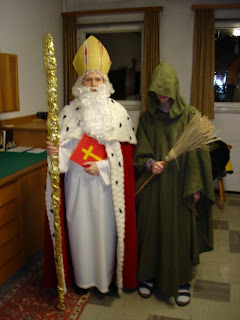St. Nikolas was an orthodox Bishop in what is now Turkey. A number of miracles were attributed to him and he became the patron Saint of children and sailors, with his own special Feast Day (Dec. 5) celebrated across Europe. Because of his habit of secretly leaving gifts, he became the model for our modern Santa Claus.
In most early depictions, Saint Nikolas has a long red cape, wears a white bishop's dress and red mitre (bishop's hat), and holds a crosier, a long gold coloured staff with a fancy curled top.
The Dutch called Saint Nikolas, Sinterklaas, which is where we actually got the name Santa Claus. Like Santa, Sinterklaas visited families and handed out presents or punishments to European children.
At some point, religious leaders disliked the somewhat rough treatment that Saint Nikolas allegedly gave to naughty children so a new character was introduced to carry out the punishments while St. Nick focused on giving presents. Here we see his new assistant, a shadowy figure in the background with a bundle of switches.
In Germany, this assistant became known as Knecht Ruprecht. According to some stories, Ruprecht began as a farmhand; in others, he is a wild foundling whom St. Nicholas raises from childhood.
Knecht Ruprecht sometimes walks with a limp, because of a childhood injury. Often, his black clothes and dirty face are attributed to the soot he collects as he goes down chimneys.
St. Nikolas and Knecht Ruprecht
St. Nikolas and Knecht Ruprecht
In the Dutch countries, St. Nikolas is accompanied by one or more assistants called Zwarte Piet (Black Peter). Often he is portrayed as a slave and dressed as a Moor.
Zwarte Piet is considered somewhat controversial in modern times. Many White Dutch see him as a cherished tradition and look forward to his annual appearance. Other Dutch people detest him, seeing the character as an expression of racism. The black-face makeup and bright red lipstick serve to maintain racial stereotypes.
While Zwarte Piet was limited pretty much to the Low Countries, most of Europe developed another assistant for St. Nikolas, the satan-like figure of the Krampus.
Just like Zwarte Piet and Knecht Ruprecht, the Krampus is one of the Saint's assistants and is used to frighten young children and give out punishments.
Most depictions of Krampus show him with a long tongue, horns and often a tail.
Often, Krampus is pictured with a basket on his back used to carry away bad children and dump them into the pits of Hell.
In many rural areas, the tradition also includes birching – corporal punishment with a birch rod – by Krampus, especially of young girls. Modern Krampus celebrations are often criticized by women because the character seeks out females for extra switching.
It's kind of creepy, but in Europe children actually have dolls of the Krampus.
As the legend has it, at some point St. Nicholas defeated the devil and enslaved him to do his bidding. the Krampus is supposedly this creature and is usually pictured with chains.
A child hugging her Krampus doll!
I think this repentant young girl is about to be birched.
It's off to the pits of Hell for this unfortunate child!
Occasionally, the young women fight back against Krampus.
Modern depictions of Krampus are pretty gruesome.
I don't know about you, but if someone like this showed up at my house I would be terrified.
These modern Krampus masks would definitely work in a horror movie.
If I were a European parent, I'm not sure I would want my children exposed to such a terrifying creature. If I was a child, I would sure want to be nice - not naughty!
Fortunately for us, our modern Santa Claus became based on the good figure of Sinterklaas and not his evil henchmen!


























This comment has been removed by the author.
ReplyDeleteI would like to get myself a Krampus doll.
ReplyDelete